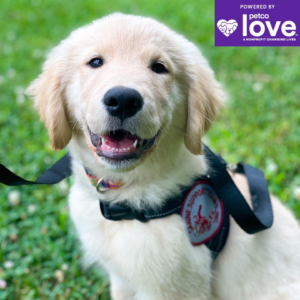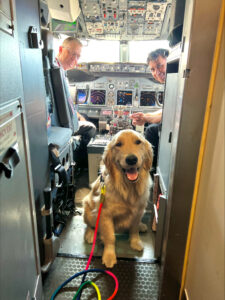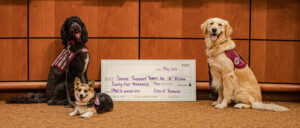Part 1 – Puppies
Separation anxiety is the fear of being left alone. It is a common problem that results in many otherwise good dogs being surrendered to shelters, due to the behaviors that can accompany this issue.
For the first several weeks of life, pups will sleep huddled together as a litter. When pups are about five weeks old, they begin to move and sleep independently. With a stable mom in a stable environment, pups will exert some independence. They don’t worry about being left alone because their life experience has been, “I wake up over here, whine a little, and rejoin my pack.” If they are removed from the litter too early (before 8 weeks), they miss those early, reassuring experiences and can develop insecure attachments.
So how can we prevent or help with separation anxiety. If you’re selecting a pup try to select a pup from good breeders, where you can see if the parents are stable dogs, and where the breeder insists on keeping pups until 8 weeks old. The better the foundation, the easier it will be to prevent anxious behaviors.
Invest in a good crate and immediately start having your pup sleep and spend time in his crate. Be sure it contains a nice bed, some good chew toys, and is placed near the family; the pup may cry at first but just ignore him. Never take him out while he is upset; let his anxiety come down first. That will help him learn to soothe himself. If you let him out while he is in a frenetic state of mind, you actually reward and reinforce the behavior. Yes, it can be hard to ignore a puppy’s plaintive wails, but let him cry it out. When he gives up and relaxes, let him out of the crate. After a few days, most pups will actually go into their crates on their own when they are tired as it becomes their new norm and feels safe. Getting a pup used to a crate can prevent so many behavioral problems down the road. I highly recommend crate training puppies.
Shara Butterworth is a Canine Behaviorist and the Director of Training for CST
Next Month, Part 2, Separation Anxiety in Rescued Dogs
Separation Anxiety – Part 2, Soothing Anxiety in Rescued Shelter Dogs
In part one, our focus was on preventing separation anxiety in young pups. What if you rescued a dog and he has separation anxiety? First and foremost, be patient; understand that he has been tossed around and doesn’t know what’s coming next. A rescued dog’s anxiety will decrease if you give him time to understand that his new situation is stable, and you’re not going anywhere. A crate will protect you and your rescued dog from his anxiety driven behaviors.
Anxiety driven behaviors can be super destructive, and dangerous. I had a client whose rescued Chesapeake Bay Retriever jumped through a window, shattering the glass. Your rescue dog will be safer and get into less trouble if he is in a crate while you’re away.
Crate training your rescue dog may take a bit longer than a pup, but he will adjust.
Dogs are quick to pick up patterns, and their anxiety will diminish as they understand and adjust to their new family’s’ routine. When you leave or return, don’t make a big deal about it; dogs will pick up on your emotions and feed off your insecurity as well. If I feel guilty for leaving my dog, and my dog senses that insecurity, he will feel anxious, too. So just relax. You knew not to cry when you left your kid at kindergarten, right? You didn’t want your child to worry, right? Be a solid, secure, confident pack leader and your anxious dog will become more secure.
When using a crate, make sure you always remove collars so they don’t get caught on crate. Provide your dog with some safe distractions like a peanut-butter filled Kong, or favorite chew toy for those short sessions when you’re away, and even when you’re home. Make the crate an enjoyable, secure space for your dog. Occasionally there are dogs that have had traumatic experiences, and medication may be necessary. Ask your veterinarian and trainer to help you with a plan.
Crate training can ease separation anxiety, and will protect you and your dog. No one wants to come home to find the furniture destroyed by an over-anxious dog, but, if it happens, understand that it was because she was anxious. Then, roll up a newspaper, and knock yourself on the head with it as you realize it could have been prevented had you put her in her crate. You are, after all, the more intelligent species, right?
Shara Butterworth is CST Director of Training, Canine Behaviorist, Service Dog Instructor






